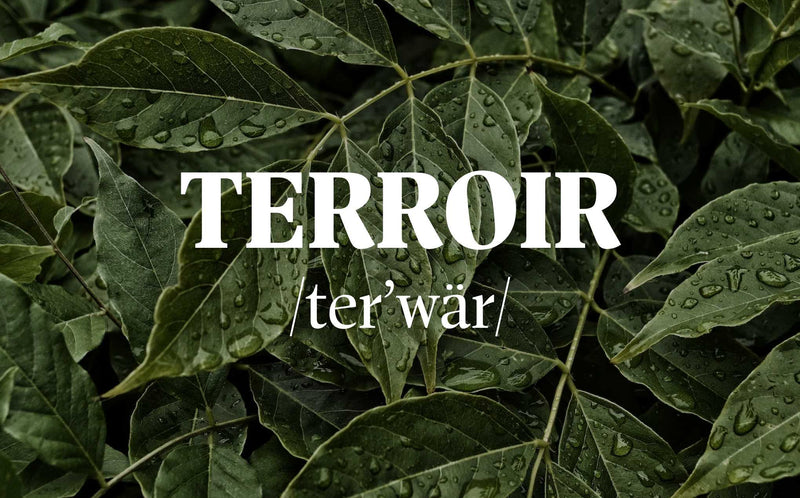Coffee Terroir: what it means and the factors that influence it
“ Terroir ” known primarily for its association with wine, is gaining more and more relevance in the world of coffee . But what does this word mean? And how does it influence the taste of our beloved coffee? Why should it arouse the interest of enthusiasts, baristas, roasters and producers?

UNESCO Definition and Meaning of Terroir
The term "terroir" was born among French winemakers who observed how wine and vineyards varied depending on the region in which they were located. It probably derives from the Gallo-Roman Latin "territorium" and would be a variation of the word "territoire": literally translated it means earth or soil . This concept, however, does not only refer to the specific characteristics of the soil composition but also to other factors that shape production.
According to UNESCO , terroir is “a delimited geographical space, defined by a human community that over the course of its history builds a series of distinctive cultural traits, knowledge and practices based on a system of interactions between the natural environment and human factors".
The concept of terroir therefore starts from the soil, but embraces a complex combination of natural and human factors. The human component, according to UNESCO, is fundamental in the development of a specific terroir. Even in coffee, terroir plays a decisive role. Each region where coffee is grown has its own terroir, which helps make each bean a unique and varied sensory experience .
Factors that influence the definition of terroir
We have seen how the definition of terroir is determined by various factors. But what are they exactly?
- Soil: the terroir of coffee is influenced by the nutrients in the soil which in turn vary depending on the territory . The highlands of Kenya have a profoundly different soil mineral composition from that of the volcanic areas of Panama. The latter are characterized by a soil rich in minerals which gives the coffee bean a rich and defined flavour.
- Climate: The aromatic notes of coffee beans are directly influenced by the amount of rain and level of sun exposure . Coffee production typically occurs in the "coffee belt " located between the tropics of Cancer and Capricorn. However, within this zone, different climates occur. An ideal climate requires a good alternation between rainy and dry seasons: rainy to stimulate plant growth and dry to encourage harvesting and drying.
- Altitude: The colder atmosphere at higher altitudes affects the ripening process of the fruit. At a higher altitude we will have a fruit with a greater concentration of sugars and, from a taste point of view, a coffee characterized by greater acidity and complexity.
- Growing and Processing Methods : Local growing and processing practices also contribute to terroir . Selecting the plants around which to grow coffee plants or choosing a traditional processing method rather than preferring an experimental one, are determining factors for obtaining a different and unique final cup.
In summary, to understand in more detail how the terroir conditions the final yield of the coffee in the cup, let's take an example. The Geisha variety is native to the Ethiopian forests and began to be cultivated in Panama after European immigrants moved to these territories in the 19th century. Even far from its origins, this variety maintains the distinctive organoleptic characteristics of Ethiopian coffees, but the terroir, specifically the climate, altitude and soil, influence the final result in the cup.
Brazilian Terroir: a unique mix of sweetness and grandeur
Brazil stands out as the world's leading producer with an annual production exceeding 50 million bags and representing over 30% of global coffee production. Centrally located in the tropical zone, coffee plantations enjoy a favorable environment thanks to optimal climatic conditions that include heat, precipitation, ideal temperatures and mineral-rich soil.
The Brazilian climate varies in the different coffee growing regions, specifically the average temperatures are between 20 and 30 degrees Celsius in the main growing areas and temperature variations do not exceed 19°C. Coffee plantations often benefit from a well-defined rainy season with abundant rainfall which, together with the mild climate, contributes to the optimal growth and maturation of the beans.
Arabica, which represents over 70% of world coffee production, finds its ideal habitat in Brazil. Its plantations are located between 900 and 1,800 meters above sea level and characterized by a climate that varies from tropical to rainy, allowing the arabica coffee beans to grow at their best, acquiring their characteristic sweet and fruity taste.
As regards processing methods, Brazil is known for the use of the "natural" and "pulped natural" methods. In the case of the former, the hot and dry climate is exploited in particular to obtain perfect drying of the fruit. Pulped natural processing, similarly, benefits from the warm temperatures and controlled humidity of Brazil.
Terroir in the world of coffee is therefore a complex mix of elements that go beyond the soil and actively involve the human component . The search for perfection in the cup of coffee passes through an in-depth understanding of how factors such as soil, climate, altitude and human intervention interact with each other, creating a unique and inimitable experience. From this profound knowledge of how terroir can influence the taste of coffee in the cup, Cellini Caffè has developed two specialty coffee blends Meraviglia and Delizia. In the latter you can appreciate the floral aromatic notes and citrus aftertaste, typical of the Brazilian terroir and of coffees produced in other countries such as Colombia, El Salvador, Ethiopia and Guatemala.


